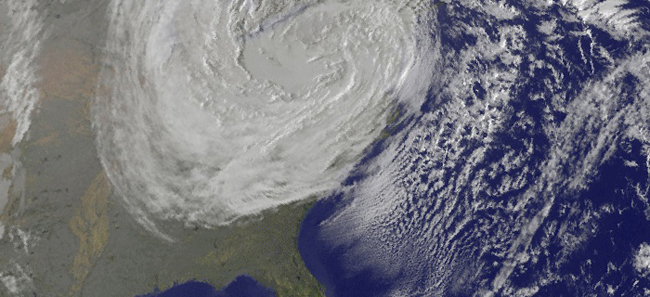When dangerous storms batter coastal communities, not all residents heed safety advisories. A new study by the Yale Project on Climate Change Communication explores what factors shape these choices.
– Kevin Dennehy, Yale School of Forestry and Environmental Studies

Photo: NASA Goddard Space Flight Center
As Hurricane Sandy inundated the U.S. East Coast in October 2012, several towns along the Connecticut coast issued "mandatory" evacuation orders. To reinforce the potential threat of storm surges, officials shared maps highlighting specific areas that were particularly vulnerable to flooding.
Yet thousands of people refused to budge.
To better understand why people make such decisions, despite ample evidence of risk, the National Oceanic and Atmospheric Administration (NOAA) is funding ten social science projects — including one by the Yale Project on Climate Change Communication (YPCCC) — that explore different facets of this thorny public communications dilemma.
The Yale researchers are surveying residents along the Connecticut coast to gauge how a range of factors, from prior experiences to political leaning, shape decisions when threatened by hazardous storms.
“We strongly suspect that there are different audiences that are going to respond to hurricane and coastal storm warnings in different ways,” said Anthony Leiserowitz, director of YPCCC. “We want to figure out who they are and why they react the way they do.”
The $150,000 grant for Yale researchers — which was announced in early 2014 by the Connecticut, New Jersey and New York Sea Grant programs — are being funded by NOAA’s Sea Grant Coastal Storm Awareness Program, which aims to improve public awareness and understanding during hazardous coastal events. Other projects receiving grants in the $1.4 million initiative are examining specific storm warning systems and how information is conveyed during these events.
The YPCCC survey, which is being conducted by telephone and is slated for completion by year's end, targets people who live within one or two miles of the Connecticut shore, including many areas battered by Hurricane Irene, in 2011, and Superstorm Sandy. During both events, many people stayed in their homes despite being warned of potentially dangerous weather conditions.
“In the case of Sandy, they actually had very accurate projections of where and when flooding was going to occur, so it wasn’t a lack of forecasting ability,” said Jennifer Marlon, an associate research scientist with YPCCC and lead investigator of the project. “They’d invested a ton in improving the predictability of these models. But the next step is getting people to understand the risks and then take appropriate actions.”
Researchers hope the survey will produce valuable insights into how much residents know about weather science, how personal experiences and opinions about government influence decisions during emergencies, and whether misconceptions affect human judgments during coastal storms.
The data will be made available in a series of analyses and papers, as well as during stakeholder meetings, Leiserowitz said. Ultimately, he said, the goal is to help public safety officials develop messages that resonate with all audiences.
"In the end, each individual living on the coast has to make a decision in real time about how they're going to respond to this specific event happening at this specific time of the year in this particular context,” Leiserowitz said. “Some of that will be unpredictable because there are too many variables.”
"But we think we can at least bring more clarity to the challenge of how to communicate to the public, which we know at a minimum is not an undifferentiated mass. There are different audiences that are predisposed to react differently to different messages."
Connecticut Gov. Dannel Malloy and William P. Shea, deputy commissioner of the state’s Department of Emergency Services and Public Protection, submitted letters supporting the YPCCC grant application.